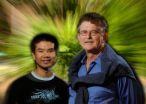(Press-News.org) If the latest theory of Tom Weiler and Chui Man Ho is right, the Large Hadron Collider – the world's largest atom smasher that started regular operation last year – could be the first machine capable causing matter to travel backwards in time.
"Our theory is a long shot," admitted Weiler, who is a physics professor at Vanderbilt University, "but it doesn't violate any laws of physics or experimental constraints."
One of the major goals of the collider is to find the elusive Higgs boson: the particle that physicists invoke to explain why particles like protons, neutrons and electrons have mass. If the collider succeeds in producing the Higgs boson, some scientists predict that it will create a second particle, called the Higgs singlet, at the same time.
According to Weiler and Ho's theory, these singlets should have the ability to jump into an extra, fifth dimension where they can move either forward or backward in time and reappear in the future or past.
"One of the attractive things about this approach to time travel is that it avoids all the big paradoxes," Weiler said. "Because time travel is limited to these special particles, it is not possible for a man to travel back in time and murder one of his parents before he himself is born, for example. However, if scientists could control the production of Higgs singlets, they might be able to send messages to the past or future."
Unsticking the "brane"
The test of the researchers' theory will be whether the physicists monitoring the collider begin seeing Higgs singlet particles and their decay products spontaneously appearing. If they do, Weiler and Ho believe that they will have been produced by particles that travel back in time to appear before the collisions that produced them.
Weiler and Ho's theory is based on M-theory, a "theory of everything." A small cadre of theoretical physicists have developed M-theory to the point that it can accommodate the properties of all the known subatomic particles and forces, including gravity, but it requires 10 or 11 dimensions instead of our familiar four. This has led to the suggestion that our universe may be like a four-dimensional membrane or "brane" floating in a multi-dimensional space-time called the "bulk."
According to this view, the basic building blocks of our universe are permanently stuck to the brane and so cannot travel in other dimensions. There are some exceptions, however. Some argue that gravity, for example, is weaker than other fundamental forces because it diffuses into other dimensions. Another possible exception is the proposed Higgs singlet, which responds to gravity but not to any of the other basic forces.
Answers in neutrinos?
Weiler began looking at time travel six years ago to explain anomalies that had been observed in several experiments with neutrinos. Neutrinos are nicknamed ghost particles because they react so rarely with ordinary matter: Trillions of neutrinos hit our bodies every second, yet we don't notice them because they zip through without affecting us.
Weiler and colleagues Heinrich Päs and Sandip Pakvasa at the University of Hawaii came up with an explanation of the anomalies based on the existence of a hypothetical particle called the sterile neutrino. In theory, sterile neutrinos are even less detectable than regular neutrinos because they interact only with gravitational force. As a result, sterile neutrinos are another particle that is not attached to the brane and so should be capable of traveling through extra dimensions.
Weiler, Päs and Pakvasa proposed that sterile neutrinos travel faster than light by taking shortcuts through extra dimensions. According to Einstein's general theory of relativity, there are certain conditions where traveling faster than the speed of light is equivalent to traveling backward in time. This led the physicists into the speculative realm of time travel.
Ideas impact science fiction
In 2007, the researchers, along with Vanderbilt graduate fellow James Dent, posted a paper titled "Neutrino time travel" on the preprint server that generated a considerable amount of buzz.
Their ideas found their way into two science fiction novels. Final Theory by Mark Alpert, which was described in the New York Times as a "physics-based version of The Da Vinci Code," is based on the researchers' idea of neutrinos taking shortcuts in extra dimensions. Joe Haldeman's novel The Accidental Time Machine is about a time-traveling MIT graduate student and includes an author's note that describes the novel's relationship to the type of time travel described by Dent, Päs, Pakvasa and Weiler.
Ho is a graduate fellow working with Weiler. Their theory is described in a paper posted March 7 on the arXiv.org physics preprint website.
INFORMATION:
For more news about Vanderbilt research, visit Research News @Vanderbilt at researchnews.vanderbilt.edu.
Large Hadron Collider could be world's first time machine
2011-03-16
ELSE PRESS RELEASES FROM THIS DATE:
Toygaroo.com Launches Nation's Largest 'Online Toy Rental Service'
2011-03-16
Toygaroo.com, an innovative new toy rental company, has launched its online service, which will help families save money and go green by not having to throw out their old toys.
Toygaroo, which has a similar format to Netflix, allows families to rent toys for their children and provide a steady rotation of high-quality toys that can grow along with them. In addition, Toygaroo will be featured on the March 25 season premiere of ABC's "Shark Tank," a show that allows entrepreneurs to pitch their business ideas to successful investors.
"Any family with children understands ...
Insulin-releasing switch discovered
2011-03-16
Johns Hopkins researchers believe they have uncovered the molecular switch for the secretion of insulin — the hormone that regulates blood sugar — providing for the first time an explanation of this process. In a report published online March 1 in Cell Metabolism, the researchers say the work solves a longtime mystery and may lead to better treatments for type 2 diabetes, the most common form of the disease.
"Before our discovery, the mechanism behind how exactly the insulin-producing beta cells in the islet of Langerhans of the pancreas fail in type 2 diabetes was incompletely ...
Poorly presented risk statistics could misinform health decisions
2011-03-16
Choosing the appropriate way to present risk statistics is key to helping people make well-informed decisions. A new Cochrane Systematic Review found that health professionals and consumers may change their perceptions when the same risks and risk reductions are presented using alternative statistical formats.
Risk statistics can be used persuasively to present health interventions in different lights. The different ways of expressing risk can prove confusing and there has been much debate about how to improve the communication of health statistics.
For example, you ...
PURE Life Experiences Leads a Radical Shift in the Travel Industry: 85% of Travel Operators Agree That "Experiences" Are 7 Times More Important Than "Price" in the Differentiation of Their Offering
2011-03-16
Experts in the travel industry are progressively turning towards Experiential Travel and Transformational Travel to stand out in a much too undifferentiated, fusional and standardised world. A recent survey created by PURE confirms this trend: travel experts provided insightful information on the new challenges that operators in the industry will soon be facing and on how it is going to be all about the "experience". For the complete report, visit http://ww.purelifeexperiences.com/pureinsights.pdf.
According to the survey, 96.5% of Experiential suppliers agree that authentic ...
Newer antimalarials more effective than quinine against severe malaria
2011-03-16
Quinine should no longer be the drug of choice for treating severe malaria, according to an updated systematic review by Cochrane researchers. It is now evident that the antimalarial drug artesunate, which is derived from herbs used in Chinese medicine, is more effective at preventing death in patients with severe malaria.
Severe malaria occurs when the disease affects the function of vital organs. It is associated with rarer cerebral malaria, which affects the brain and can lead to long-term disability. More than a million people die each year from severe malaria, the ...
Tests on century-old equipment show how far X-rays have come
2011-03-16
OAK BROOK, Ill. – Researchers recently tested first-generation x-ray equipment from 1896 and found that it produced radiation doses and exposure times that were vastly higher than those of today's systems, according a study published online and in the May print edition of Radiology.
"To my knowledge, nobody had ever done systematic measurements on this equipment, since by the time one had the tools, these systems had been replaced by more sophisticated ones," said the study's lead author, Gerrit J. Kemerink, Ph.D., from Maastricht University Medical Center in the Netherlands.
Wilhelm ...
Study: Multi-tasking on the street not a good idea for older people
2011-03-16
CHAMPAIGN, Ill. — Older adults may put themselves at risk by talking on cell phones while crossing the street, researchers report in a new study. The researchers found that adults aged 59 to 81 took significantly longer than college students to cross a simulated street while talking on a mobile phone, and their heightened cautiousness in initiating crossing did nothing to improve their safety. Older adults on cell phones also were more likely to fail to cross in the time allotted for the task.
The findings, from researchers at the University of Illinois, appear in the ...
New articles examine safety of airport security scanners
2011-03-16
OAK BROOK, Ill. – The Transportation Security Administration (TSA) has begun to use whole-body imaging scanners as a primary screening measure on travelers passing through airport security checkpoints. One type of scanner employs millimeter wave technology, which delivers no ionizing radiation. However, the second type of scanner currently deployed at airports uses backscatter X-rays that expose the individual being screened to very low levels of ionizing radiation. In the April issue of Radiology, two articles address the question of what potential long-term public health ...
The drama of starbirth
2011-03-16
The star-forming region NGC 6729 is part of one of the closest stellar nurseries to the Earth and hence one of the best studied. This new image from ESO's Very Large Telescope gives a close-up view of a section of this strange and fascinating region (a wide-field view is available here: eso1027). The data were selected from the ESO archive by Sergey Stepanenko as part of the Hidden Treasures competition [1]. Sergey's picture of NGC 6729 was ranked third in the competition.
Stars form deep within molecular clouds and the earliest stages of their development cannot be seen ...
New health insurance survey: 9 million adults joined ranks of uninsured due to job loss in 2010
2011-03-16
New York, NY, March 16, 2011—An estimated nine million working-age adults—57 percent of people who had health insurance through a job that was lost—became uninsured in the last two years, according to the Commonwealth Fund 2010 Biennial Health Insurance Survey, released today. The survey paints a bleak picture for the 43 million adults under age 65 who reported that they or their spouse lost a job in the past two years, finding that job losses are often compounded by the loss of health insurance, leaving families vulnerable to catastrophic financial losses and bankruptcy ...



